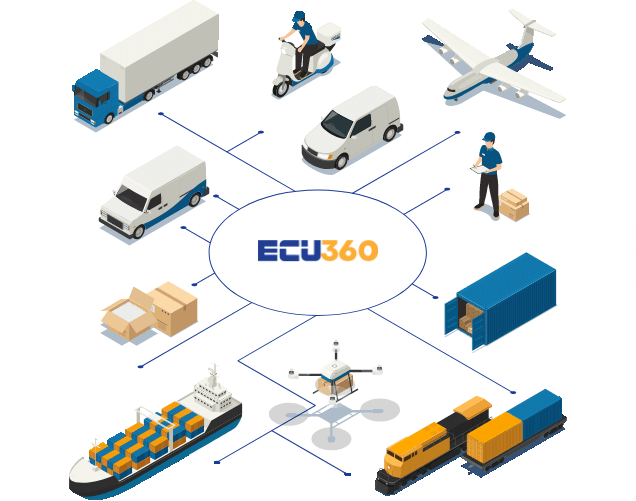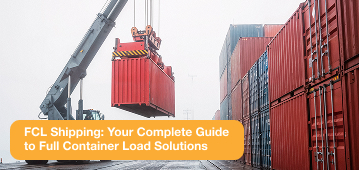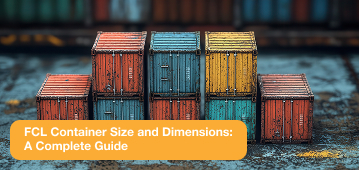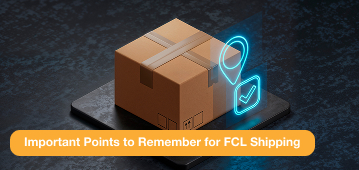How to Book Your FCL Shipment: A Step-by-Step Guide for Hassle-Free Shipping
If your business deals with large shipments that require exclusive use of a container, FCL shipping (Full Container Load) is your most efficient and cost-effective option. But to fully leverage its benefits, understanding the FCL booking process is key. Whether you’re new to shipping or simply want a more structured system, this guide will walk you through how to book your FCL shipment, including all the essential steps and tips.
Let’s simplify FCL logistics service and break it down into manageable steps for seamless global shipping.
What is FCL Shipping?
Full Container Load (FCL) refers to a shipping method where one party uses the entire space of a shipping container; either 20ft, 40ft, or 40ft HC. This method offers greater cargo security, fewer touchpoints, and more predictable transit times compared to shared containers (LCL – Less than Container Load).
Businesses often choose FCL shipping when they have:
- Large volume shipments
- Fragile or sensitive goods
- High-value items requiring secure transit
- A need for lower cost per unit (for bulk shipping)
Step 1: Confirm Cargo Readiness and Quantity
Before starting the FCL booking process, ensure your cargo is:
- Packed and palletized (if required)
- Labeled accurately
- Documented for weight and volume
Estimate your container requirement based on cargo volume:
| Container Type | Capacity |
|---|---|
| 20ft | ~28 CBM |
| 40ft | ~58 CBM |
| 40ft HC | ~68 CBM |
Pro Tip: Choosing the right container size can help reduce overall FCL shipping costs and ensure cargo safety.
Step 2: Choose a Reliable Freight Forwarder
A good freight forwarder is the bridge between you and the shipping line. They help with:
- Selecting the optimal route
- Getting competitive freight quotes
- Coordinating documentation and customs
- Providing real-time updates on your shipment
Look for freight forwarding companies that specialize in FCL logistics solutions, especially if you’re new to international container shipping.
Step 3: Request a Freight Quote
When reaching out to a forwarder, include:
- Type of goods
- Origin and destination ports
- Estimated cargo weight and volume
- Preferred shipping dates
- Any special handling instructions
You’ll receive a quote based on container size, distance, fuel surcharges, port fees, and more. Some companies also offer port-to-port delivery options or end-to-end service depending on your logistics needs.
Step 4: Finalize Booking and Confirm Container Availability
Once you agree on the quote:
- Book FCL shipment formally through your freight forwarder.
- Choose your desired shipping schedule.
- Check container availability in advance (especially in peak seasons).
The shipping line or forwarder will issue a booking confirmation that includes the container number, seal number, vessel name, voyage number, and Estimated Time of Departure (ETD).
Step 5: Prepare Export Documentation
Accurate documentation ensures your shipment isn’t delayed or held at customs. Common documents for FCL freight booking include:
- Commercial Invoice
- Packing List
- Bill of Lading
- Export License (if applicable)
- Certificate of Origin
- Insurance Certificate (optional but recommended)
Incorrect or missing documents can result in fines, delays, or even shipment rejection. Export documentation is a key part of the FCL logistics service chain.
Step 6: Container Pickup and Loading
You can load your cargo at:
- Your premises (if you’re doing shipper-loaded FCL)
- A designated warehouse or freight station
Tips for efficient FCL cargo loading:
- Distribute weight evenly
- Secure cargo using straps and bracing
- Avoid overloading to respect container weight limits
- Double-check seal placement
Freight forwarders can help arrange cargo pickup and delivery as part of their services.
Step 7: Customs Clearance and Container Handover
Before the container boards the vessel, it must pass customs clearance at the origin port. Your freight forwarder usually coordinates this. Key steps include:
- Filing Shipping Bill
- Submitting documents digitally (via ICEGATE in India)
- Getting clearance from Customs and Port Authorities
Once cleared, the container is moved to the port and handed over to the shipping line for loading onto the vessel.
Step 8: Track Shipment and Prepare for Arrival
Once your FCL shipment is on board:
- Use the booking confirmation number or container number to track its journey online
- Stay in touch with your forwarder for real-time updates
- Prepare for import customs clearance at the destination port
You’ll need to provide the required documents at the receiving end and arrange for last-mile delivery if needed.
FCL Booking: Pro Tips for Smooth Experience
Here are some expert tips to ensure your FCL shipping experience is smooth:
- Plan Ahead: Container shortages and vessel delays are common in global logistics. Book your shipments in advance.
- Know Your Deadlines: Shipping lines have cut-off times for documentation and container gating. Don’t miss them.
- Work with Professionals: A trustworthy freight forwarder will simplify everything from freight quote request to cargo unloading.
- Avoid Surprises: Understand what’s included in your FCL quote—some may exclude port handling or documentation charges.
Why FCL is a Smart Choice for Businesses
Still unsure whether FCL shipping is for you? Here are some reasons to consider:
- Security: Your cargo isn’t mixed with others, minimizing the risk of damage or loss.
- Efficiency: Fewer touchpoints and transshipments reduce delays.
- Cost: Economical for bulk or high-volume shipments.
Whether you’re shipping electronics, industrial components, consumer goods, or machinery, Full Container Load shipping is often the go-to choice for large-scale exporters.
Final Thoughts
Booking an FCL shipment may seem complex at first, but with the right planning, partners, and preparation, it can be a smooth and efficient process. From cargo readiness and quote requests to customs clearance and tracking, each step plays a role in successful Full Container Load shipping.
With the growing demand for international trade, mastering the FCL freight booking process is not just good logistics—it’s smart business.
Need Help with FCL Shipping?
At ECU360, we specialize in FCL logistics solutions tailored to your shipping needs. Our experienced team ensures timely bookings, end-to-end documentation support, and real-time tracking.
Request a freight quote today and move your cargo the smarter way.
Like





Comments